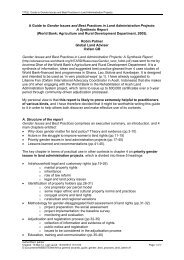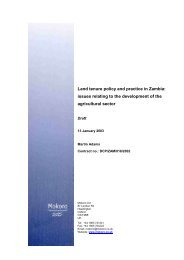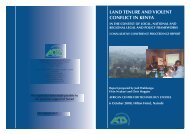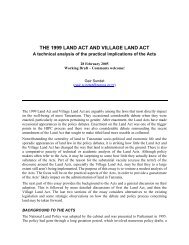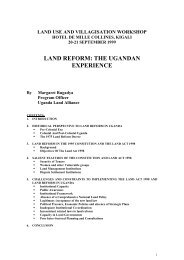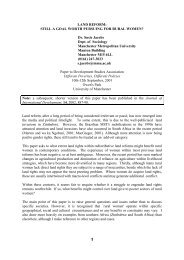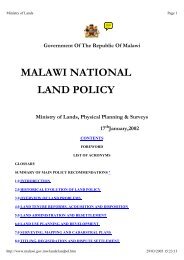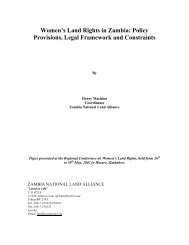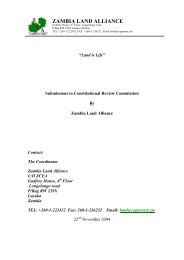Download - Mokoro
Download - Mokoro
Download - Mokoro
- No tags were found...
Create successful ePaper yourself
Turn your PDF publications into a flip-book with our unique Google optimized e-Paper software.
424. Increase employment in agriculture and the rural nonfarm economy, andenhance skills (World Bank 2007:24).In order to “make smallholder farming more productive and sustainable”, states shouldincrease the “quantity and quality of public investment” in agriculture and improve priceincentives for smallholders. They should intervene in factor and product markets,promoting targeted vouchers to enable smallholders to access crucial inputs atsubsidised cost, and the state to provide funding to distributors of inputs in new areas(World Bank 2007:13-17). Subsidies for small farmers, including input subsidies, areback on the agenda for states concerned with rural poverty. Further, states shouldsupport smallholder producer organisations, to guard against elite capture and exclusionof the poor, and to enable them to access inputs, market their produce, and become apolitical force, and should invest in research and development, raising public funding inthis area geared towards smallholder producers, for low-cost production technologiesless dependent on bought inputs (World Bank 2007:18). Despite a focus on how landmarkets can facilitate change, the WDR explicitly emphasises the importance of landreform in changing how land is used, at what scale, and with what technology. Itacknowledges that “redistributing under-utilized large estates to settle smallholders canwork if complemented by reforms to secure the competitiveness of beneficiaries –something that has been difficult to achieve (World Bank 2007:12). For urbanizingeconomies like South Africa, the WDR proposes that the priorities across these sectorsare to:Increasing the access of smallholders to assets, particularly land, andincreasing their political voice in unequal societies, can enhance the sizeand competitiveness of the smallholder sector. Beyond farming, territorialapproaches to planning are being pursued to promote local employmentthrough interlinked farming and rural agroindustry, and these processesneed to be better understood for wider application. Agricultural growth isespecially important to improve well-being in geographic pockets ofpoverty with good agricultural potential… [and] support to the agriculturalcomponent of the livelihoods of subsistence farmers will remain animperative for many years (World Bank 2007:25).In order to drive forward such an agenda, and to make this politically feasible,governments should recognise the trade-offs between the political interests of (1) theagribusiness sector, processors and retailer, (2) market-oriented smallholders, (3) thelarge mass of subsistence producers with diversified livelihoods and (4) agriculturalworkers and others employed in the rural non-farm economy (World Bank 2007:346).Policy Options for Land and Agrarian ReformProgramme for Land and Agrarian Studies, University of the Western Cape




